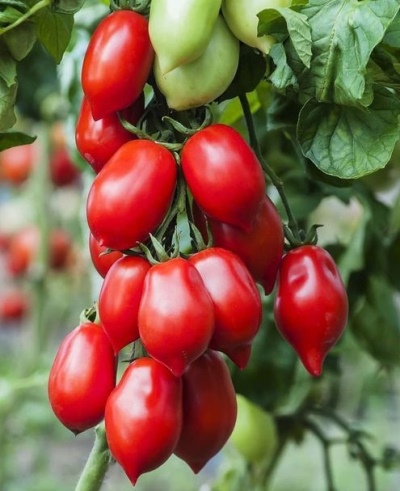
- Authors: Kachainik V.G., Gulkin M.N., Karmanova O.A., Matyunina S.V. (Agrofirma Aelita LLC)
- Year of approval: 2015
- Category: grade
- Growth type: determinant
- Appointment: fresh consumption, for pickling and preserving
- Ripening period: early
- Ripening time, days: 105-110
- Growing conditions: for open ground, for film greenhouses
- Bush size: medium-sized
- Bush height, cm: up to 100
A tomato feast for the whole world can give a very good result. But only if everything is prepared in advance and correctly. Therefore, it is necessary to collect the most complete information.
Breeding history
This plant was created in the well-known agrofirm "Aelita". The state registration of the variety was completed in 2015. The work on the project was carried out by such breeders as:
- Kachainik;
- Karmanova;
- Gulkin;
- Matyunin.
Description of the variety
For the World Feast, the determinant of development is typical. This culture is therefore very convenient for gardeners. Its bushes are tall and can reach 1 m. The foliage is medium in size. Typical for her is a dark green color.
The main qualities of the fruit
When the berries of this variety are just laid in the ovaries, they are light green in color. When ripe, the fruits turn red. They are of average size and usually weigh 0.06-0.09 kg. In shape, the berry resembles an ellipse and has only a slight ribbing. From 10 to 15 tomatoes develop on one cluster, and the inflorescences of this culture are of a complex type.
Taste characteristics
Everything is pretty simple here:
- the pulp of this variety is dense;
- it has excellent meatiness;
- the skin of the fruit is quite strong;
- pleasant sensation, typical in general for quality tomatoes;
- the suitability of berries for home canning.
Ripening and fruiting
A feast for the whole world allows you to feast on the fruits quite early. It usually takes 105-110 days from throwing out the green growth to acquiring commercial qualities of tomatoes. Mostly it is possible to remove the fruits in July. But weather conditions and agricultural practices can greatly affect this indicator.
Yield
The declared productivity is from 8 to 8.5 kg per 1 sq. m. Such a small spread suggests that the weather will have almost no effect on the amount of collection. However, with severely unfavorable weather conditions or with gross errors in growing, problems are inevitable.
The timing of planting seedlings and planting in the ground
It is necessary to sow Pir's seeds all over the world in containers with prepared substrate in March or April. The specific period should be chosen by the gardeners themselves, since only they can assess the situation. Planting too early in containers is more likely to be detrimental. Most often, the readiness of seedlings for transshipment into open ground is achieved in May. But even here it is necessary to assess the situation.

Growing tomato seedlings is an extremely important process, because it largely depends on whether the gardener will be able to harvest at all. All aspects must be taken into account, from seedbed preparation to planting in the ground.
Landing scheme
All information on this matter is provided in third-party sources. The recommended width of the ridges is 120 cm. The length is chosen arbitrarily, as it will be convenient. The most optimal location is the placement of holes in the 400x500 mm system.

Growing and care
It will be very difficult to do without a garter to the support. Fruit cracking is unlikely. However, it can occur when the growing conditions are violated (too intensive watering, excessive rainfall). At least the minimum resistance against late blight is achieved only under the condition of preventive treatment. You can grow a Feast for the whole world in the following conditions:
- European part of Russia;
- The Far East;
- Ural and Siberian regions;
- Volga region;
- North Caucasus.
In any of these regions, it is appropriate to plant tomatoes when the danger of night frosts has completely disappeared. If the transplant is not in open ground, but under a film, it can be carried out 2 weeks earlier. The seed is selected very carefully. It is disinfected in a pink solution of potassium permanganate. The seeding depth is from 1 to 2 cm, the earth is moistened, but dampness is excluded.
Young shoots do not need moisture too much, however, overdrying the soil is unacceptable. It is best to water the tomato once every 2-3 days. Watering with a syringe or a teaspoon helps to exclude damage to poorly developed roots. Seedlings are picked at the age of 17-20 days; before this, the seedlings must be watered with a light pink solution of potassium permanganate. If the seedlings are hatched in well-fertilized soil, additional fertilizing will not be needed.
Seeds must be sown with a reserve. This will allow you to select the strongest and most developed seedlings. Vegetable crops are considered the best predecessors for Pir throughout the world. Increased acidity is defeated by liming. The transplanted specimens are kept at rest for 10-14 days.




A plant needs different micronutrients at each stage of growth. All fertilizers can be divided into two groups: mineral and organic. Folk remedies are often used: iodine, yeast, bird droppings, eggshells.
It is important to observe the rate and period of feeding. This also applies to folk remedies and organic fertilizers.



























































































